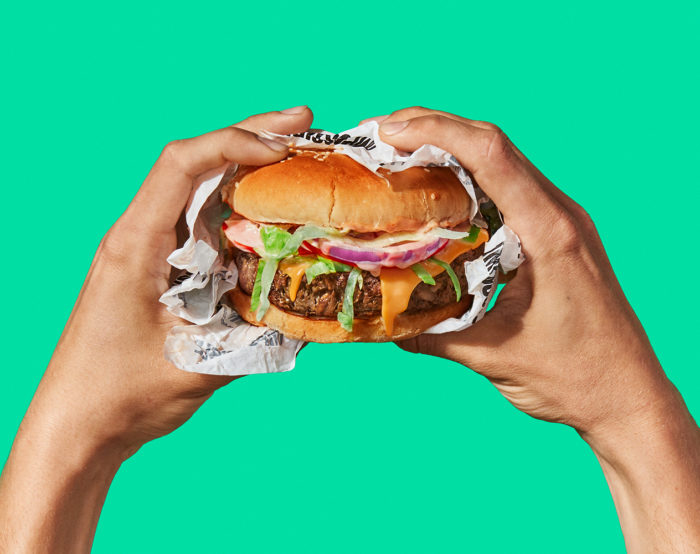A few weeks ago, I saw an ad for “bone-in” chick’n drumsticks from a local restaurant. Apparently the “bone” is a little wooden stick shoved in the middle of a lump of plant-based chicken in the shape of a drumstick. My immediate thought was, “ew.” Why in the world would I want to mimic eating a dead animal’s cooked flesh, if that is the very thing I am trying to avoid doing?
It was around this time that my friend’s non-vegan boyfriend asked me why vegans want to eat food that resembles meat. “Why wouldn’t they just eat the meat?” He asked. Aside from the obvious answer, it got me thinking about vegan food culture. There seems to be two options for plant-based restaurants. Vegan, whole food meals or vegan food that mimics the meals we used to consume as meat eaters—things like Big Macs or fried chicken.

I think it’s fantastic that traditional fast food restaurants are starting to include options for vegans and vegetarians. For example, there is surely some novelty in buying the “Imposter,” a Beyond Meat chick’n burger from KFC. And I’d be lying if I said I didn’t want to try it. But that’s where it gets confusing for me: when does it go too far? When does my desire to experience eating meat-like food cross the line and conflict with my desire to avoid it?

One of the best examples of this is the Impossible burger, which is engineered to “bleed.” Hearing that was a little problematic for me. In fact, it made me want to avoid it altogether. Eating a food that makes me think of animal cruelty is a huge turn-off for me, as I’m sure it is for other vegans. It makes me question what the point of creating a vegan burger that can “bleed” actually is.
I suppose the short answer is: to prove we don’t need to kill animals to experience a specific taste or look. But what does it take to get those results? As The Beyond Burger and the Impossible burger have gained popularity, it also received a lot of backlash by CEOs of companies like Whole Foods and Chipotle, who warn against the deceivingly unhealthy nature of the products.
John Mackey, the Whole Foods CEO, said, “The [brands] who are capturing the imagination of people—and I’m not going to name these brands because I’m afraid I will be associated with the critique of it… But some of these that are extremely popular now that are taking the world by storm, if you look at the ingredients, they are super, highly processed foods.” Mackey has been vegan for over 20 years. Beyond Meat was first launched at Whole Foods, and the brand—as well as other “highly processed” plant-based meat, continue to be available at the chain.
In response to my friend’s boyfriend, I simply replied that eating food like that isn’t ideal. It’s not the goal for most vegans. It’s a great starting point, to help transition meat-eaters into a vegan diet, or an occasional indulgence, but it shouldn’t be the cornerstone of a vegan diet. I’ll admit there are tons of times I crave non-vegan food. I do miss my favorites, but more so for the nostalgia they hold. A tunafish sandwich is actually a kind of disgusting concept to me now. But I crave it from time to time because it was a staple in my youth. I think I want the nostalgia it produces more so than I do the taste.

As Bee Wilson writes in The Guardian, “The existence of realistic fake meat products raises interesting questions about what meat really is. When we say we love meat are we really talking about a set of nutrients? A certain flavor or texture? Or a set of cultural memories of shared meals such as Christmas turkey and Easter lamb?”
Plant-based meat challenges the way we think about our food. If we can have the same flavor profile, the same nutrients, the same associated memories with a specific food—why not make a choice that has less of an impact on our environment, such as vegan alternatives to meat have?
And I think that’s really the goal behind plant-based meat products: it caters to people who are concerned about the environment more so than those who care about animal rights. And its goal is to not turn people vegan or to “make new vegans”—it’s to make non-vegans eat more vegan meals. That might be disappointing to some vegans, but in terms of actual individual lives saved, it matters more that a majority of people opt for vegan meals over meat sometimes, than that a small number of vegans always eat vegan meals. Consider plant-based milks, for example, which have soared in recent years not just due to the small number of lactose-intolerant people and vegans, but due to the “regular” people who are ditching dairy for health or taste reasons. That increase in plant-based milk consumption has led to a drop in dairy production.
As much as I may have a concern with consuming meat-mimicking meals personally, I can appreciate the concept behind them. While you won’t catch me chewing the “meat” off a chick’n drumstick any time soon I would encourage my meat-eating friends to give it a try.
How do you feel about plant-based meat, is it something you avoid or something you look forward to consuming often?
__
Photo: Impossible Burger; KFC; Rolande; Kallergis; Unsplash.





